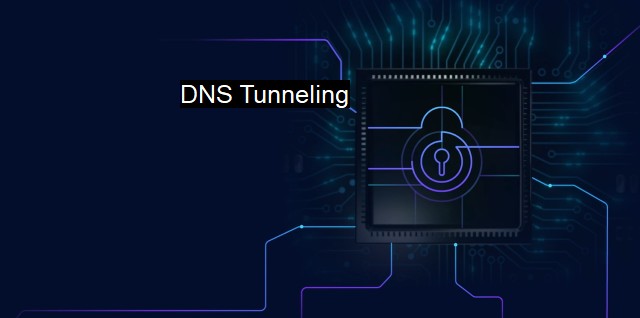What is DNS Tunneling?
DNS Tunneling: Malware's Covert Communication Method to Evade Detection and Bypass Traffic Filtering
DNS Tunneling is a powerful technique in the world of cybersecurity that pirates and hackers frequently use to maliciously invade computer systems, manipulate information, orchestrate data breaches, and carry out related illicit activities.Before diving deeper into this concept, let's first understand what DNS means. DNS, or Domain Name System, primarily functions like a phone book for the internet. Just like fetching a phone number after identifying the person you want to call, DNS helps computers translate human-readable domain names like "www.google.com" into numerical IP addresses required for locating and loading internet resources.
While DNS protocol is essential for ensuring that the internet runs smoothly, cybercriminals often gamble on its lesser-known function – tunneling, and exploit it for their whims and fancies.
DNS Tunneling is a method where cybercriminals encapsulate the non-DNS traffic in DNS protocols, effectively paving an escape route for them over the DNS port back to their servers. It is crucial to know that not all DNS tunneling is necessarily malicious. It is sometimes used by businesses to circumvent geo-restrictions when needed, albeit very rarely. what's chiefly concerning is that hackers can misuse this often-overlooked network loophole for a variety of unethical purposes like bypassing network firewalls, achieving intrusion into the system unnoticed, generating command and control signals for malicious payload, data exfiltration, and more.
Data within DNS requests isn't ordinarily screened, leading to a significant blind spot in network security measures. Hackers often exploit these blind spots to establish a two-way command, control, and data transfer channel while breaching target systems. The most alarming part of this type of attack is that given their nature, most standard security measures seem to have no effect, and hackers can invade, command, and exit a system leaving little to no trace of their visit.
Delving deeper, a typical DNS tunneling attack scenario would look roughly as follows. The attacker sets up a server with a registered domain. While on the victim's side, a malware is installed, which generates DNS queries including the payload information, intended for the malicious server. This communication takes place in the clear, completely bypassing regular network security measures as routine DNS traffic is generally considered harmless. Once established, this communication can exfiltrate sensitive data, obtain unauthorized access, or even command other malicious software on infected devices.
To counter these DNS tunneling threats, multi-layered defense models should be employed. Companies can start by enforcing stronger egress filtering that leverages deep-dive inspections into the DNS requests and responses, anomaly detections, rate limiting, and employing entropy and lexical analysis.
Artificial intelligence and machine learning methods have emerged as a solid line of defense against DNS tunneling techniques, identifying irregular patterns and connections that mimic the behavior of tunnel-based DNS attacks. It's also important to remember to terminate unnecessary recursion on external facing DNS servers, curbing one possible attack avenue.
Regular logging and scrutinizing of DNS logs can provide robust insights into any unusual occurrence or pattern, helping in preemptive identification of an attack possibility. Thus, monitoring traffic and alerting authorities about anomalies in real time, combined with diligent security awareness and training, can empower enterprises to grasp atypical patterns indicative of security attacks swiftly.
Lastly, installing reliable antivirus software and keeping it updated to shield servers from intrusion attempts and the latest threats can also significantly contribute to improved system safety. Antivirus works in tandem with other cybersecurity practices to not just identify but also rectify security threats.
As per a saying in the cybersecurity paradigm, it’s better to prevent and prepare than to repent and repair. It's high time organizations appreciated the complexity of DNS tunneling and the tremendous damage it could wreak, investing suitable resources for defensive measures dutifully.

DNS Tunneling FAQs
What is DNS tunneling?
DNS tunneling is a technique used by cybercriminals to bypass security measures by encapsulating non-DNS traffic in DNS packets.How does DNS tunneling compromise cybersecurity?
DNS tunneling enables attackers to send and receive encrypted data, which may contain malware or stolen information, without being detected by traditional security measures like firewalls or intrusion detection systems.How can antivirus software detect DNS tunneling?
Antivirus software can analyze DNS queries and responses to detect abnormalities or patterns consistent with DNS tunneling. Additionally, some antivirus products include specific DNS tunneling detection features to detect and block this type of threat.What are some best practices for preventing DNS tunneling attacks?
To prevent DNS tunneling attacks, organizations should implement strong firewall rules, control DNS server access, regularly monitor DNS traffic, and use secure protocols such as HTTPS. Additionally, ensuring that antivirus software is up-to-date and configured properly can help detect and block DNS tunneling attacks.| | A | | | B | | | C | | | D | | | E | | | F | | | G | | | H | | | I | | | J | | | K | | | L | | | M | |
| | N | | | O | | | P | | | Q | | | R | | | S | | | T | | | U | | | V | | | W | | | X | | | Y | | | Z | |
| | 1 | | | 2 | | | 3 | | | 4 | | | 7 | | | 8 | | |||||||